So you’ve got your own boat. As it’s coming from the factory, there are options aplenty. Customisation of features is something that a lot of makers are putting across the table these days. The options can be highly attractive too, with factory spec sheets showing such goodies as live wells for bait and catch (plumbed or otherwise), extra seats with accompanying spigots, drink holders, berley buckets, custom wraps, a bimini, storage bins, rod lockers, rod holders, rod racks, cleats and rails, cockpit lighting, deck wash and side pockets.
Even extra compartments within cast decks are negotiable these days. Mandatory of course, are transducer brackets and a pod up front on which to mount an electric motor. In boats likely to be ranging far and wide, a radio is a smart investment in safety. Fish finders and other nav aids are pretty much standard these days and as even small tinnies are seen sporting high end sounder/plotters, somewhere to mount a unit is essential. There’s lot of money tied up in that list of options, so where does it start and end? Starting is easy: ending is the problem in my view.
The size of the boat and its construction will have a major bearing on features. While it might seem easier to add extras to an alloy craft than a glass one, a lot of quality glass-makers are incorporating useful options as well, to maintain sales in today’s very competitive market.
Starting with a glass boat, it makes sense to have side pockets within the cockpit work area, rod racks or rod holders horizontally mounted along at least one cockpit side wall. If there’s an option to have rod tips tucked up within the side deck up front and out of harm’s way, it’s worth looking at. Rod lockers aren’t always offered, as many prefer to have easily accessible rods.
Live bait wells are a great selling point in any boat and can usually be set into a transom corner. Ask the question, ‘Are we really going to fish with live bait?’ If it’s not a priority, then save your money. A catch well large enough to keep the day’s prize in is a must, but it pays to find out if it can be drained and cleaned after use, to ensure fishy smells are finalized.
A berley bucket is always handy in any boat – all it takes is a mounting point set up at the factory and it’s up to the crew to see if they want the berley bucket along on a trip. Cockpit lighting is useful. While not everyone fishes at night, some boaters have it installed to sort things out in the boat at night, if lighting is poor where the craft is stored. Cleats are handy in any craft, and if the pocket is deep enough, pop up style cleats are a great asset. Totally unobtrusive until required, they’re worth the extra money involved.
Forward seating is offered in walkaround or centre console glass rigs. If a storage compartment is offered under that seat, so much the better. A deck wash is handy in any larger boat and well worth the money, even it it’s just to clean up at the end of fishing.
Rod holders are a huge asset in any larger boat, but beware of rocket launcher style rod holders that might put rods right up on top of a hard top or other framework and make them hard to access. A well constructed bait station that isn’t cockpit intrusive and equipped with inbuilt rod holders is very good value, as a rod can be placed in the holder while terminal tackle is worked on.
Electronic aids and a radio are standard in any larger rig. My only suggestion regarding the sounder/plotter is to purchase the very best you can afford, as it’s a mighty investment in fishing pleasure. With a larger craft, which glass rigs tend to be, the depth of the pocket is always the decider for the extent of the options list. The overriding factor is necessity.
Alloy craft start at smaller sizes than glass ones. Moving away from small tinnies, where options can be limited to things such as a factory installed flat floor, bow mount thruster plate, paint or rails, extras are certainly available for rigs over 4m.
From the outset it makes sense to consider some of the pros and cons of the options I’ve already mentioned. They can also apply to alloy rigs, especially larger ones. A popular one for alloy craft is variable seating, which means that extra seat spigots are installed in places where they might be useful to distribute weight, for extra crew, or perhaps assist in the style of fishing. If the boat has a cast deck up front and a seat spigot is optional up there, it might be better to have a spigot installed for a smaller bicycle style seat, rather than a full sized one that takes up more room.
Carpet flooring is a big seller in alloy craft, especially hookless carpet. Ticking the box for this stuff is very wise. Many times I’ve let an Owner treble touch my standard carpet flooring and had to use pliers to extract it – a waste of time while my wife is catching fish.
Rod lockers seem to be offered a fair bit in larger alloy craft. In my view, it’s a toss up between these somewhat bulky items and standard horizontal side mounted racks. It comes down to available cockpit space – if it’s not sufficient then horizontal racks are fine. Vertical ones also useful when set up on consoles. Side pockets are handy so long as they don’t intrude too far into the cockpit and gobble up work area.
Live wells and live catch wells are useful assets if suited to the fishing style, and if they’re large enough to be worthwhile. Unfortunately, some catch wells are too small to be useful. Have a look at one already installed in the sort of boat under consideration, to see if it’s large enough to do the job. Are you targeting mackerel? Then a bream and bass sized catch well is useless. Plumbing to live catch wells is vital, especially for competition anglers. It’s worth the extra dollars to have it set up from the outset.
Anchor wells are a source of complexity. If the well is not drained, then a wet anchor warp might cause issues in time. If there’s no lid on the well, consider if the anchor rope will bounce out under way in rough, going by the shape of the anchor well.
Additional compartments for fuel (tote) tanks are a possible source of annoyance. Some manufacturers insist on making them so confined that a cast deck hatch over the top of a full tote tank just won’t close properly. Measure the area to ensure the tote tank will fit, especially if the compartment has been set up for either equipment or tote tank storage.
Somewhere to mount the sounder in a smaller alloy rig is a priority. If a side mini console type mounting point is available, go for it.
The main issue with any optioning up of a rig is not to overdo things. Cluttering a rig with more seats, things that overly intrude or take up space, or items that will seldom ever be put to use is simply wasting money. Manufactures hugely boost their profits from the extras, as a look at an options price listing will rapidly confirm, so it makes sense to consider most of the likely fishing scenarios and then assess how a range of selected options might best assist that fishing.
Reads: 14229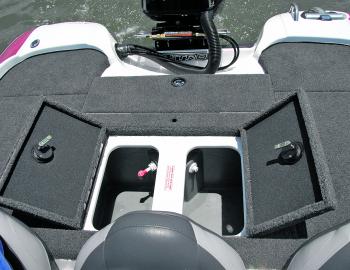
That’s a decent live well. Optioning for one that large would be great.
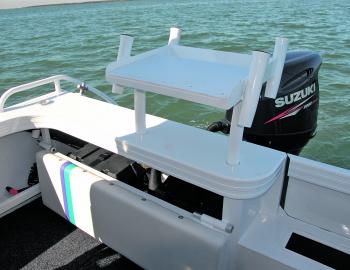
A drop down rear seat is a great option to provide extra room in a fishing cockpit. Note the deck wash there as well.

Upright rod racks are a useful option in a console craft and ensure optimisation of space.
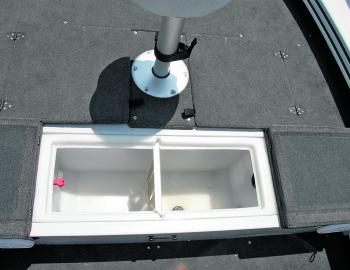
A live well and removable live well are versatile – an option worth considering.
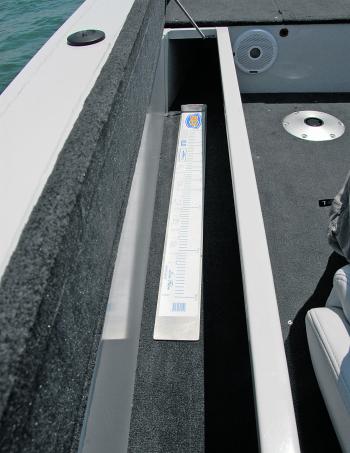
A rod locker set up with hookless carpet will save you a lot of trouble.

A mini console is ideal for setting up a sounder in a smaller craft. It should get the tick when options are considered.
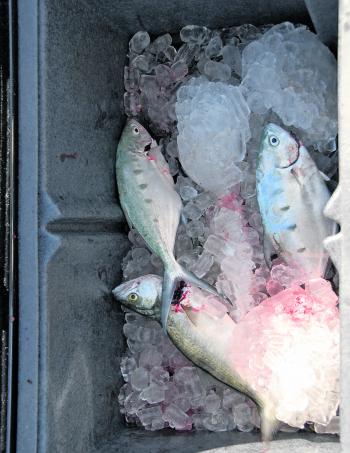
The morning’s catch – it’s a handy catch well. It won’t hold a mackerel, that’s for sure.
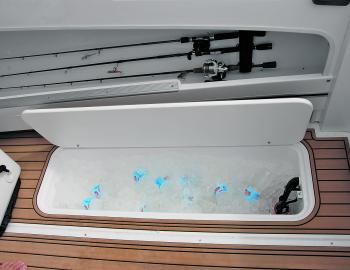
A catch well of those proportions isn’t going to be cheap. If you’re confident about your offshore fishing, the outlay makes a lot of sense.
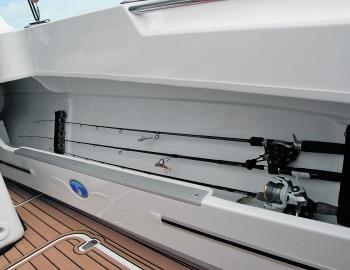
A set of rod holders like these will be an asset in a fishing craft.
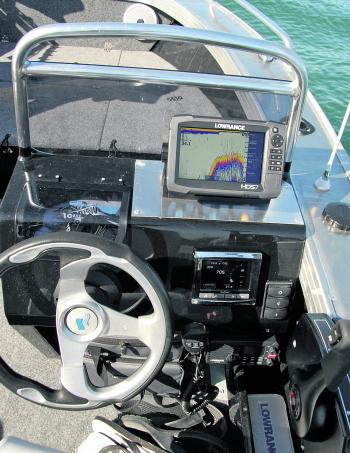
Setting up the sounder in just the right spot is always important in a smaller alloy rig. Quintrex got it right with this one.

There’s a pack of good options here. Deck wash, rod holders in side pockets and a decent bait station are all handy in a fishing rig.
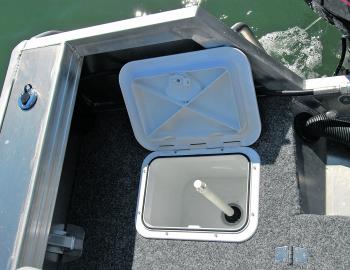
Even a smaller live well such as this one can be useful in a rig where live baiting is part of the fishing fun.
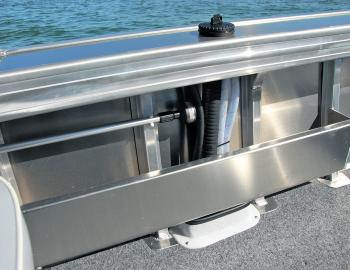
This side pocket is compromised by the plumbing.
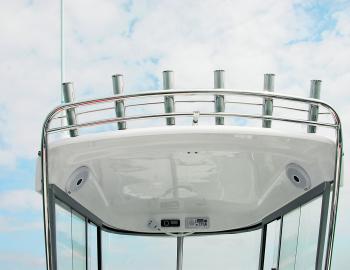
Optional rocket launcher style rod holders are great, but it’s better to ensure rods are still within easy reach.




